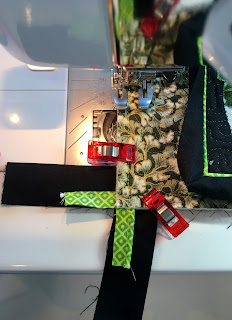 |
| Here's the photograph I used to design my quilt. |
The first step is to find a photograph you like. I wasn't given a lot of guidelines for this, so I wasn't sure what would work. I end up choosing a picture I took soon after moving to Tokyo, of a ginkgo tree's leaves, right as they start to turn to gold.
 |
| The "finished" top, with a layer of tulle to hold it (mostly) in place. There was some shifting as I carried it home. |
To cut the fabric confetti, you need to have a sharp rotary cutter. Some people sliced their material so the pieces are square, but I like the rectangle shapes better. I think your eye doesn't flow over the square shapes as well as the rectangular ones (sorry, I don't have a picture so show the difference).
After you have a collection of fabric chopped up, you can cut your batting and backing to the size you want for the finished quilt. The batting ends up forming the background for the quilt top. It helps to grip the little bits of fabric, though if you want a specific color, you can put a piece of fabric on top of the batting. Once I place the tree pieces down, I can scatter the confetti leaves all over the quilt top. That's it! The top has now been "pieced."
 |
| black tulle |
Then you can add some more detail with the quilting. I choose to stitch some ginkgo leaves on the tree. After doing some research online to look at the leaf shapes (it's March, so there's no leaves on the trees) and practicing - first by sketching, then on a practice quilting piece - I'm ready to add them to my quilt. (Side note - the BEST pictures to use for quilting ideas are tattoo designs. You can usually find ones that look like a simple sketch. Very helpful to transpose for quilting!)
 |
| Can you find the ginkgo leaves? |
 |
| There they are! |
 |
| Ginkgo leaves growing off the tree branches... |
 |
| I think this one works for the piping! |
 |
| adding the binding and piped cording |
I test out different fabrics, and decide I like the diamond patterned lime green. It's a pretty easy process to make the piping, and it's not difficult to add to the quilt. (Though when the directions tell you to baste it on with a contrasting thread, actually use a contrasting thread so you can easily see it. It ends up being your guide for sewing on the binding, so you want it to be visible - and it's hidden inside the binding, so it won't show.) My Clover Wonder clips, which I haven't used often, come in handy in this situation!
Here's the finished quilt! Since the tree leaves are changing, the picture was taken right after I arrived in Tokyo and it's a different quilt style for me, I think "Changes" is an appropriate name for it.
 |
| Changes |
You can't see much of the quilting on the back because of the ginkgo leaf print. However, it was too perfect not to use - I had already purchased the fabric at Tomato, before I even started working on this project.
 |
| Ginkgo leaves on the back, too! |
No comments:
Post a Comment